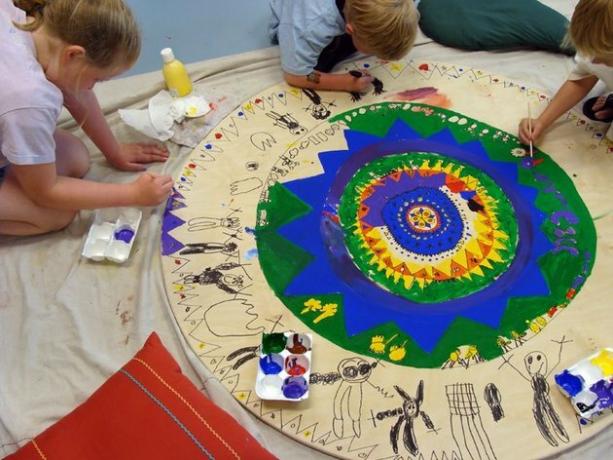THE mandala it is, originally, a circle that contains in its interior drawings of geometric shapes, human figures and varied colors.
They are found in religions such as Buddhism and Hinduism, as well as in the culture of North American Indian tribes such as the Sioux.
Mandala meaning
The word mandala means circle in Sanskrit and is regarded as a symbol of healing and spirituality. For Hindus and Buddhists, the mandala helps in the concentration of meditative practice and it is common to find it in the temples of this religion.

Tibetan mandalas are made of sand and require a long time to prepare. There is no pattern of decoration for the interior of the mandalas and therefore, there are mandalas that bring the figure of Buddha, while others show only geometric figures.
The Mandala for Native American Peoples
Among Native Americans, the mandala is believed to have the power to protect and ward off evil dreams and evil spirits. Therefore, it is also called the dream filter.

An ancient indigenous legend tells that a mother could not get her child to sleep at night.
So she sought help from the tribe's healer who recommended her to make a circle with a labyrinth inside and hang it. The mother did so and the child was able to sleep peacefully as the bad dreams got caught in the tangle of lines.
The Mandala in Christianity
Although not used for healing purposes, mandalas are present in Christianity. The rosettes of Gothic cathedrals can be considered mandalas.
The fact that this symbol is widespread in so many cultures reflects the meaning the circle has for the subconscious. As it is not a geometric shape found in nature, it perfectly translates the idea of perfection that human beings want to achieve.

The Mandala in Psychology
The mandala was also used by Swiss scholar Carl Jung (1875-1969) to explain the human psyche. Jung made an analogy between the composition of the mandala and the three levels of consciousness we have.
The central point of the mandala is identified with the self, the essence of our being, from which everything converges or radiates. The first figures in the mandala would be the personal unconscious and, finally, the furthest edges would be the collective unconscious.
The Mandala in Education

Mandalas are a didactic resource used by many teachers of art, history and mathematics, as this symbol serves to teach various topics such as:
- geometric shapes;
- Colors;
- size differences;
- sets;
- visual perception;
- art history;
- history of religions.
Making the mandala allows the student to exercise their autonomy and individuality, leaving their personal mark. It is interesting to set up an exhibition with the students' works in order to show the diversity of each class.
Likewise, some educators use the mandala for classes considered very agitated due to the calming power that the realization of this drawing contains.
Mandala Benefits
The benefits of making and painting a mandala are many. The maker stays focused on a specific task and thus can channel their attention.
In this way, he enters a state of concentration comparable to the mystical trance. Likewise, the same kind of focus that happens to athletes and musicians when they are doing their jobs.
In addition, the author exercises his creativity and decision-making power when dealing with the choice of different colors and geometric patterns.
Thus, the mandala has been used for treatments in pathologies such as attention deficit, depression, stress and as occupational therapy.
read more
- Buddhism
- Hinduism
- Indian culture
- Gothic art



